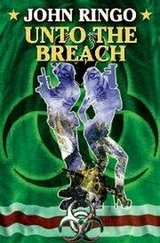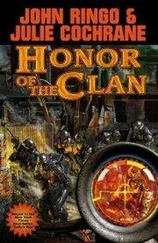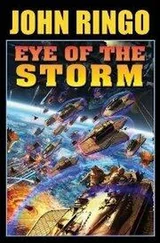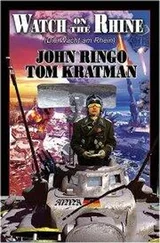John Ringo - When the Devil Dances
Здесь есть возможность читать онлайн «John Ringo - When the Devil Dances» весь текст электронной книги совершенно бесплатно (целиком полную версию без сокращений). В некоторых случаях можно слушать аудио, скачать через торрент в формате fb2 и присутствует краткое содержание. Год выпуска: 2002, ISBN: 2002, Издательство: Baen Books, Жанр: Боевая фантастика, на английском языке. Описание произведения, (предисловие) а так же отзывы посетителей доступны на портале библиотеки ЛибКат.
- Название:When the Devil Dances
- Автор:
- Издательство:Baen Books
- Жанр:
- Год:2002
- ISBN:978-0743436021
- Рейтинг книги:3 / 5. Голосов: 1
-
Избранное:Добавить в избранное
- Отзывы:
-
Ваша оценка:
- 60
- 1
- 2
- 3
- 4
- 5
When the Devil Dances: краткое содержание, описание и аннотация
Предлагаем к чтению аннотацию, описание, краткое содержание или предисловие (зависит от того, что написал сам автор книги «When the Devil Dances»). Если вы не нашли необходимую информацию о книге — напишите в комментариях, мы постараемся отыскать её.
When the Devil Dances — читать онлайн бесплатно полную книгу (весь текст) целиком
Ниже представлен текст книги, разбитый по страницам. Система сохранения места последней прочитанной страницы, позволяет с удобством читать онлайн бесплатно книгу «When the Devil Dances», без необходимости каждый раз заново искать на чём Вы остановились. Поставьте закладку, и сможете в любой момент перейти на страницу, на которой закончили чтение.
Интервал:
Закладка:
The lines along the Eastern seaboard had been stable for nearly two years. Each side had strengths and weaknesses and the combination had settled into stalemate.
The Posleen had extremely advanced weaponry, hundreds of generations better than the humans. Their light-weight hypervelocity missiles could open up a main battle tank or a bunker like a tin can and every tenth “normal” carried one. The plasma cannons and heavy railguns mounted on the God King’s saucers were nearly as effective and the sensor suite on each saucer swept the air clear of any aircraft or missile that crested the horizon.
In addition to their technological edge they outnumbered the human defenders. The five invasion waves that had hit Earth, and the numerous “minor” landings in between, had ended up dropping two billion Posleen on the beleaguered planet. And it only took two years for a Posleen to reach maturity. How many there were on Earth at this point was impossible to estimate.
Of course not all of those had landed on North America. Indeed, compared to the rest of the world the U.S. was relatively unscathed. Africa, with the exception of some guerrilla activity in central jungles and South African ranges, had been virtually wiped from the map as a “human” continent. Asia had suffered nearly as badly. The horselike Posleen were at a distinct disadvantage in mountainous and jungle terrain, so portions of Southeast Asia, especially the Himalayas, Burma and portions of Indochina, were still in active resistance. But China and India were practically Posleen provinces. It had taken the horses less than a month to cross China, repeating Mao’s “Long March” and, along the way, slaughtering a quarter of the Earth’s population. Most of Australia and the majority of South America, with the exception of the deep jungle and the Andes spine, had fallen as well.
Europe was a massive battleground. The Posleen did poorly in extreme cold, not from the cold so much as an inability to forage, so both the Scandinavian peninsula and the Russian interior had been ignored. But Posleen forces had taken all of France and Germany except portions of Bavaria and swept around in an unstoppable tide to take all the North German plain to the edge of the Urals. There they had stopped more from distaste for the conditions than any military resistance.
At this point there was resistance throughout the Alps and down through the Balkans and Eastern Europe but the beleaguered survivors remained low on food, manufacturing resources and hope. The rest of Europe, all of the lowlands and the bulk of the historically “central” zones, were in Posleen hands.
America, through a combination of luck, terrain and strategic ruthlessness had managed to survive.
On both coasts there were plains which, except for specific cities, had been ceded to the Posleen. But the north-south mountain ranges on both sides of the continent, along with the Mississippi, had permitted the country to reconsolidate and even locally counterattack.
In the West the vast bulk of the Rockies protected the interior, preventing a link-up between the Posleen trapped in the narrow strip of land between the mountains and the sea. That narrow strip of land, however, had once contained a sizable percentage of the population of the U.S. and the effect of the dislocation and civilian loss there was tremendous. In the end most of the residents of California, Washington and Oregon made it to safe havens in the Rockies. Most of them found themselves in the still-building underground cities, the “Sub-Urbs” recommended by the Galactics. There they sat, working in underground factories to produce the materials the war needed and sending forth their hale to defend the lines.
There were many untapped sources of materials in the Rockies and all of them were being exploited, but what was missing was food production. Prior to the first landing all holds had been released on agricultural production and the American agricultural juggernaut had responded magnificently. But most of the spare food had ended up being sent to the few fortified cities on the plains. They were scheduled to hold out for five years and food was their overriding concern. So there was, elsewhere, a severe shortage when the first massive landing occurred. Almost all the productive farmlands in the west, with the exception of the Klamath Basin, had been captured by the Posleen. So most of the food for the Western Sub-Urbs had to be provided over a long, thin link across the Northern Plains following I-94 and the Santa Fe Railroad. Sever that link and eighty-five million people would slowly starve to death.
In the east it was much the same. The Appalachian line stretched from New York to Georgia and linked up with the Tennessee River to create an uncrossable barrier from the St. Lawrence to the Mississippi. The Appalachians, however, were nothing compared to the Rockies. Not only were they lower throughout, but they had passes that were nearly as open as flatland. Thus the Posleen found numerous places to assault all along the line. And the fighting at all of them, Roanoke, Rochester, Chattanooga and others, had been intense and bloody. In all the gaps regular formations, mixed with Galactic Armored Combat Suits and the elite Ten Thousand, battled day and night against seemingly unending waves of Posleen. But the lines held. They held at times only because the survivors of an assault were too tired to run, but they held. They bent from time to time but nowhere had they ever been fully sundered.
The importance of the Appalachian defenses could not be overstated. With the loss of the coastal plains, and much of the Great Plains, the sole remaining large areas for food production were Central Canada, the Cumberland plateau and the Ohio Valley. And although the Canadian plains were high quality grain production areas, their total production per acre was low and they were effectively unable to produce a range of products. In addition, while there was increasing industry throughout British Columbia and Quebec, the logistical problems of a broad-based economy in nearly sub-Arctic conditions that had always plagued Canada continued even in the face of the Posleen threat. It was impossible to shoehorn the entire surviving population of the U.S. into Canada and if they did the survivors would be no better off than the Indians huddling in the Gujarrat and Himalayas.
Lose the Cumberland and Ohio and that would be for all practical purposes the end of active defense. There would be humans left on the continent, but like all the other major continents, they would be shattered survivors digging for scraps in the ruins.
Knowing that the lower Great Plains were indefensible the forces there, mostly armor and Galactic armored suits, had retreated, never engaging unless they could inflict terrific casualties. This retreat had ended near the Minnesota River for much the same reason as the Siberian retreat. However, the Posleen had succeeded in one objective, whether they knew it was an objective or not. In the long withdrawal, the 11 thMI, the largest block of GalTech Armored Combat Suits on Earth, was destroyed.
All of these defenses were predicated on the Posleen’s major weaknesses: inability to handle artillery and inability to cross significant barriers. The God Kings were able to engage aircraft and missiles with almost one hundred percent certainty but still were unable to stop indirect, free-flight artillery. So as long as they were in artillery range of humans they were vulnerable. And because of their odd mental dichotomy, it was virtually impossible for them to overrun modern defensive structures. Posleen attacks that carried the first layer of a prepared defense normally involved casualty rates of one hundred Posleen for every human killed; even with their overwhelming numbers they simply could not take more than the front rank of a prepared defense. And virtually all the defenses along the Rockies and Appalachians were layered with large units up and multiple supporting units. So the Posleen came on and they died in such vast numbers that it was impossible to count. And they lost. Every time.
Читать дальшеИнтервал:
Закладка:
Похожие книги на «When the Devil Dances»
Представляем Вашему вниманию похожие книги на «When the Devil Dances» списком для выбора. Мы отобрали схожую по названию и смыслу литературу в надежде предоставить читателям больше вариантов отыскать новые, интересные, ещё непрочитанные произведения.
Обсуждение, отзывы о книге «When the Devil Dances» и просто собственные мнения читателей. Оставьте ваши комментарии, напишите, что Вы думаете о произведении, его смысле или главных героях. Укажите что конкретно понравилось, а что нет, и почему Вы так считаете.











